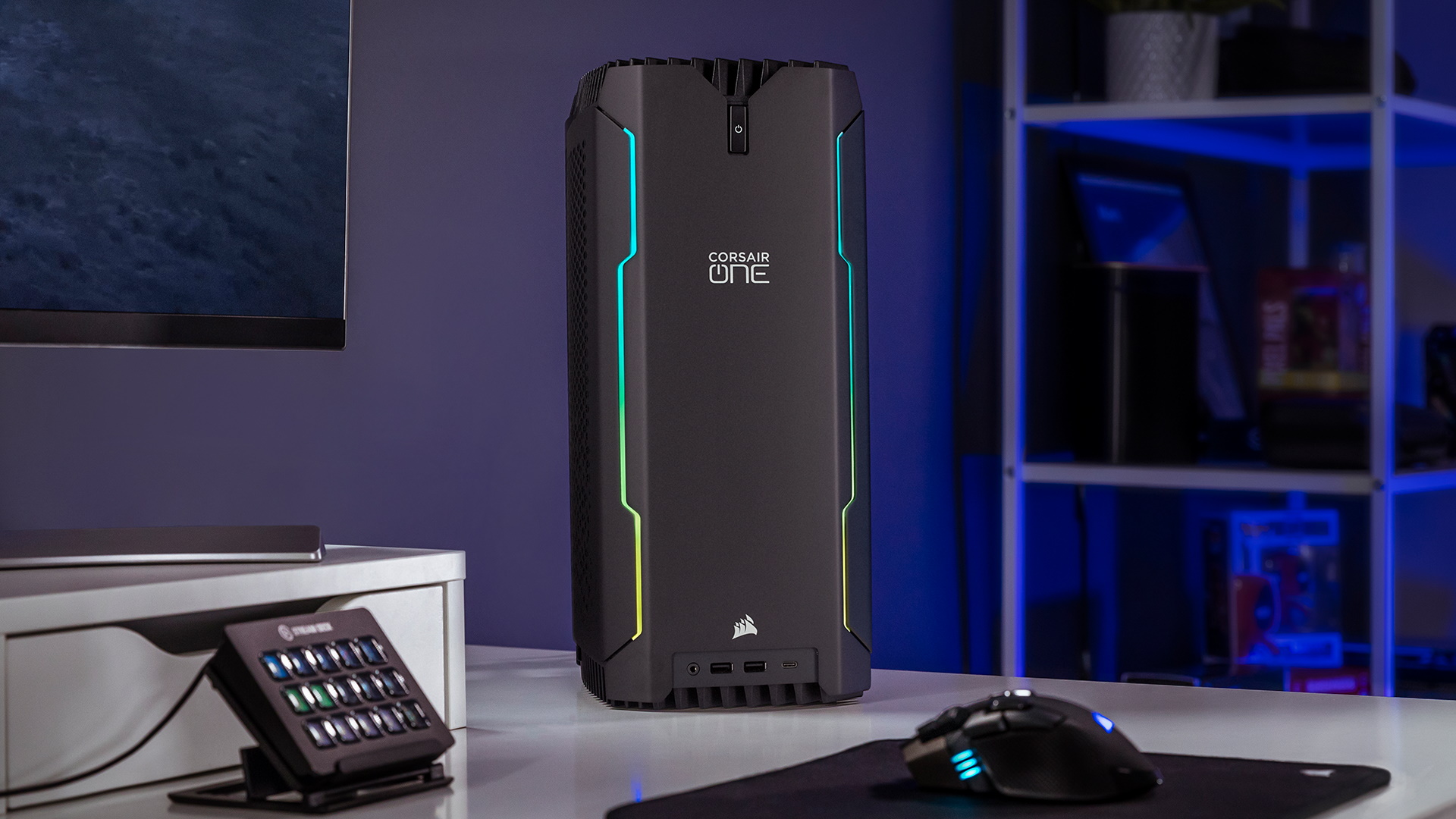Our Verdict
Corsair brings its compact gaming machine bang up to date with Alder Lake, DDR5, and a GeForce RTX 3080 Ti, to produce a 4K gaming powerhouse.
For
- 4K gaming powerhouse
- Awesome hardware throughout
- Great understated looks
- Quiet/Silent running
Against
- CPU can run hot
- Incredibly expensive
PC Gamer's got your back
The Corsair One i300 is the latest version of the compact high-end gaming PC. It's been updated to use Intel's top-end Alder Lake Core i9 12900K and comes with the kind of impressive spec list that almost makes sense of its incredibly steep price tag of $4,999 (making it the most expensive Corsair One to date.) Not only do you get a GeForce RTX 3080 Ti inside that brilliant chassis, but there's 64GB of DDR5-4800 and a speedy 2TB NVMe SSD in there too. That's a lot of cutting-edge hardware for what can only be described as a helluva lot of money.
This is an important update for a high-end system like the Corsair One because when you're dropping this kind of cash on a PC, you need to know that you're getting the best hardware around. The Intel Core i9 12900K certainly falls into the camp. That Corsair has coupled it with the RTX 3080 Ti confirms this as a gaming rig too, as the more-expensive RTX 3090 only really makes sense for those looking at professional rendering and workloads.
CPU: Intel Core i9 12900K
GPU: Nvidia GeForce RTX 3080 Ti
RAM: 64GB (4x 16GB) DDR5-4800
Storage: 2TB NVMe PCIe 4.0 SSD
Front I/O: 1x 3.5mm audio, 2x USB 3.2 Gen 1, 1x USB 3.2 Gen 2 Type-C
Rear I/O: 4x USB 3.2 Gen 1, 2x USB 3.2 Gen 2, 2x Thunderbolt 4 Type-C, HD Audio, 3x DisplayPort, 1x HDMI
OS: Windows 11 Pro
Dimensions: 200 x 176 x 380 mm
Weight: 7.18 Kg
Warranty: 2 Years
Price: $4,999
Don't dismiss the memory or storage in this rig either. DDR5 is currently incredibly hard to get ahold of. In 64GB trim like we have here, you know you're not going to come up lacking in any game on this front is welcome. Yes, it's overkill, but it means you won't need to upgrade anytime soon.
The NVMe SSD (an OEM Samsung drive equivalent to the 980 Pro) is a speedy beast as well, responsible for the fastest load times I've yet seen in Final Fantasy XIV, as well as for making for a great experience when transferring the benchmarking suite on to the machine. The fact that it's a 2TB model gives you plenty of room to play around with too and means you don't need some second-tier storage for your data.
One instant takeaway from the Corsair One i300, and something that hasn't changed too much since it first appeared on the scene, is the chassis. The idea of this being a beautiful PC is often banded around with expensive builds, but here it's genuinely warranted. This is a machine that you not only want to have in clear view on your desk, but it won't take up much room, or make too much noise if you do. Honestly, this thing is much smaller than you might think, measuring half as deep as most mid-tower systems.
This beauty is more than just skin deep too. The design allows Corsair has to use just a single fan at the top of the unit to pull air through the system to keep everything running cool. The processor and graphics card both use water cooling loops to pull heat away from them, with the single fan doing all the hard work. This fan also only spins up if needed, so for plenty of normal work this machine is effectively silent. And when it does spin up, it's nowhere near as loud as most desktop PCs.
This design isn't completely without its issues though. When you're dealing with high-end kit, temperatures can get toasty. Very toasty. The Core i9 12900K in this build is a power-hungry chip (drawing up to 241W), and it can run hot when stressed even in much bigger systems with triple-fan coolers. Here, I witnessed the CPU temps touch 100°C a couple of times in testing, resulting in the chip throttling back—although only briefly even when pushed hard. This is still an incredibly powerful CPU too, so even allowing for this brief throttling, it's still one of the fastest machines I've ever used, and tops plenty of the benchmark tables.
Importantly, the graphics card didn't run anywhere near as hot as the CPU. Even under prolonged testing in a variety of games at 4K, it topped out at 75°C, and on average ran much cooler than that. This means it doesn't hold that GeForce RTX 3080 Ti back when it comes to gaming, which is exactly what you need to hear when dropping this much cash on a machine. It never gets loud either, even when the fan is running at full pelt—you can hear it, but it isn't annoying.
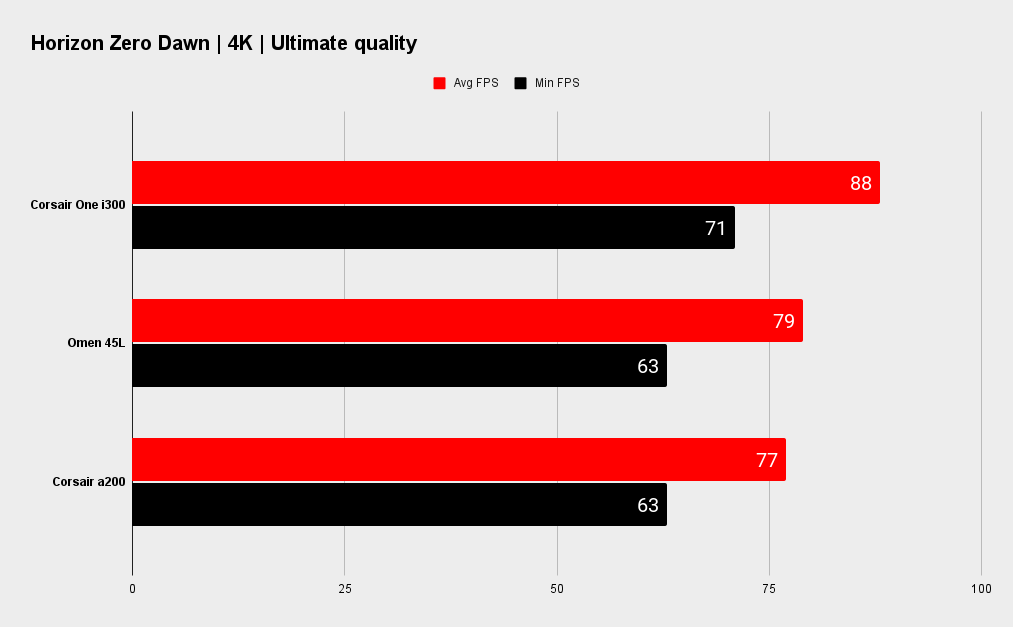


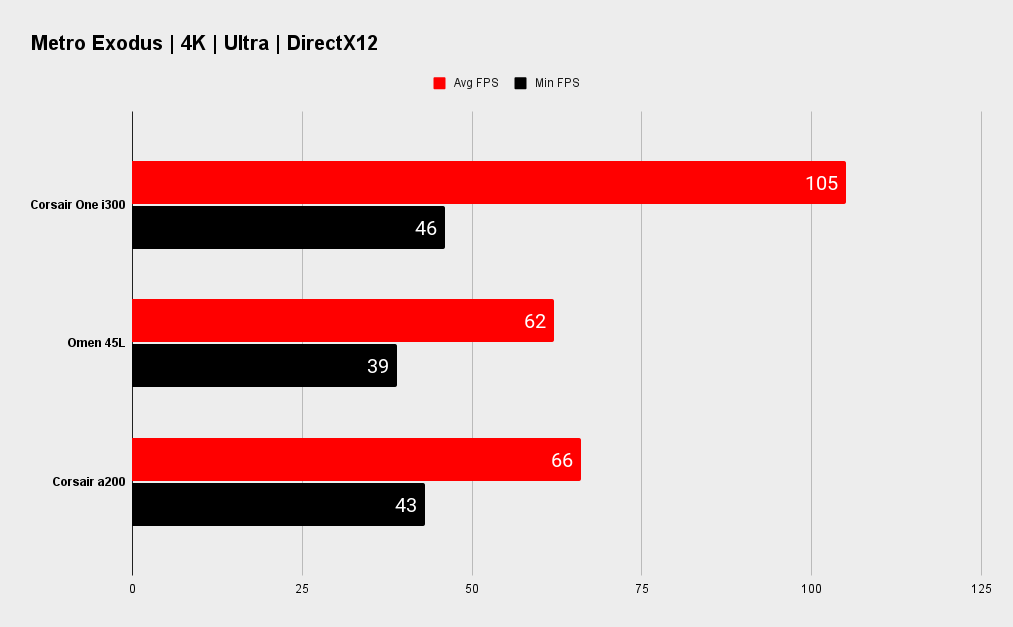

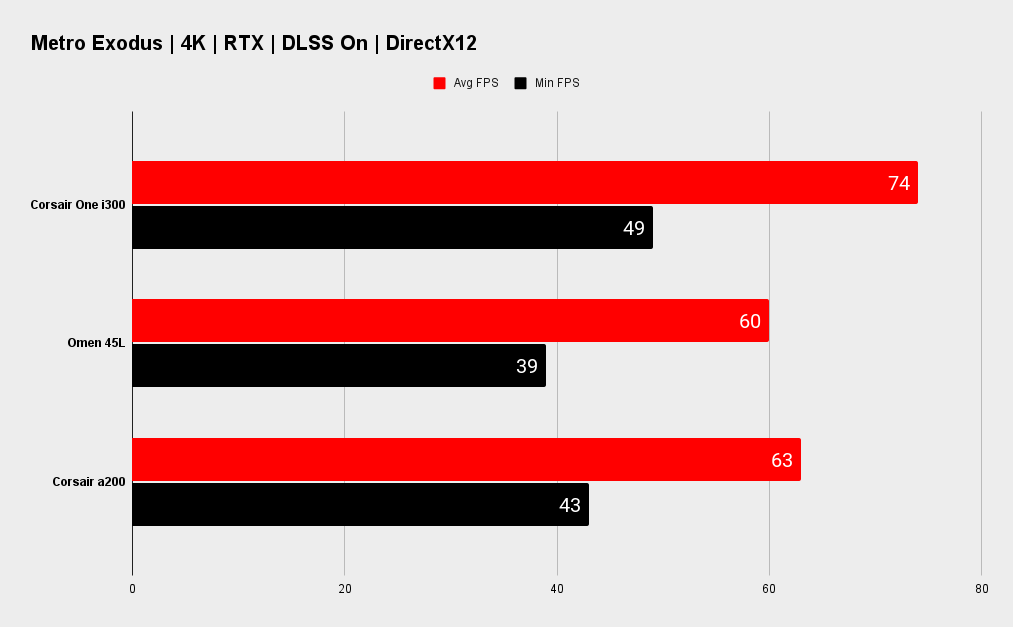
When it comes to testing there's certainly a lot to like here, with some of the fastest benchmark results around. Synthetic benchmarks, such as the raytracing showcase, 3DMark Port Royal, produced the highest score in the labs so far. Something that is backed up in the RTX rendition of Metro Exodus, where it left all but the RTX 3090-powered Alienware Aurora R12 eating beautifully rendered dust. Losing out to the much more expensive card feels reasonable here.
The important thing is of course that this PC can game, and game incredibly well. You'll get the kind of high frame rates that esports monitors were built for at 1080p and at 1440p for that matter. Up the resolution to 4K and you're still in with a good shout of tipping over into 100fps in plenty of games.
This thing is a beast. A quiet, purring beast that can also handle itself with more serious pursuits too.

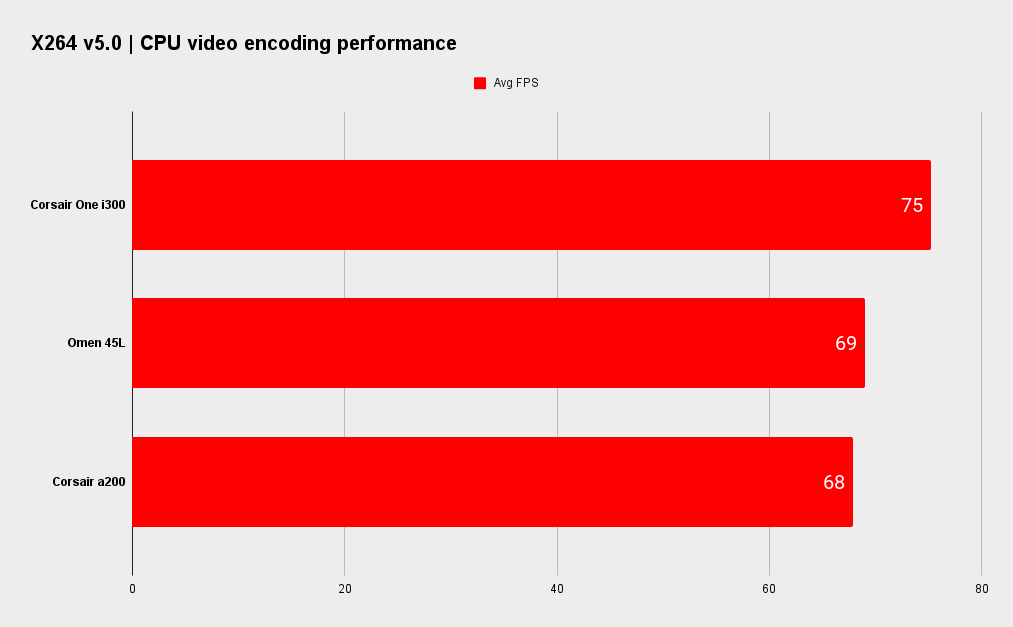

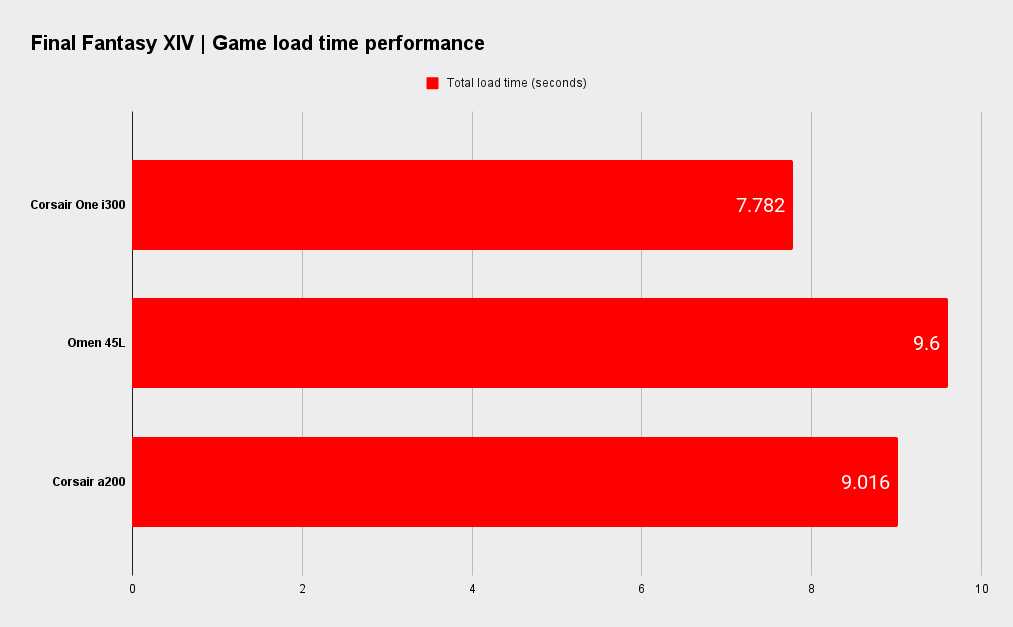
You can configure the Corsair One i300 in a couple of ways, although the Core i9 12900K is the only option when it comes to the CPU. You can go with an RTX 3080 instead of the 3080 Ti, which limits the build to 32GB of DDR5 as well, although that does shave a cool $1,000 off the asking price, so that could make sense. Even so, there's something brilliantly over the top with this 64GB system that makes it all the more tempting.
Not that this is an easy machine to justify to yourself, let alone anyone else. And yes, you could, in theory at least, build a similar spec'd machine to this for a lot less, although good look actually getting your hands on that graphics card or DDR5 RAM for that matter. And importantly it wouldn't look anywhere near as good as this or run as cool and quiet as this does for the vast majority of the time.
Overall, the Corsair One i300 ably achieves what it sets out to do. It's a compact gaming PC that showcases the latest technology an impressively smart, and dare I say, beautiful case. It's a machine that many gamers would love to own, but few can afford. But for those that can... it's a treat.
Corsair brings its compact gaming machine bang up to date with Alder Lake, DDR5, and a GeForce RTX 3080 Ti, to produce a 4K gaming powerhouse.
Alan has been writing about PC tech since before 3D graphics cards existed, and still vividly recalls having to fight with MS-DOS just to get games to load. He fondly remembers the killer combo of a Matrox Millenium and 3dfx Voodoo, and seeing Lara Croft in 3D for the first time. He's very glad hardware has advanced as much as it has though, and is particularly happy when putting the latest M.2 NVMe SSDs, AMD processors, and laptops through their paces. He has a long-lasting Magic: The Gathering obsession but limits this to MTG Arena these days.
